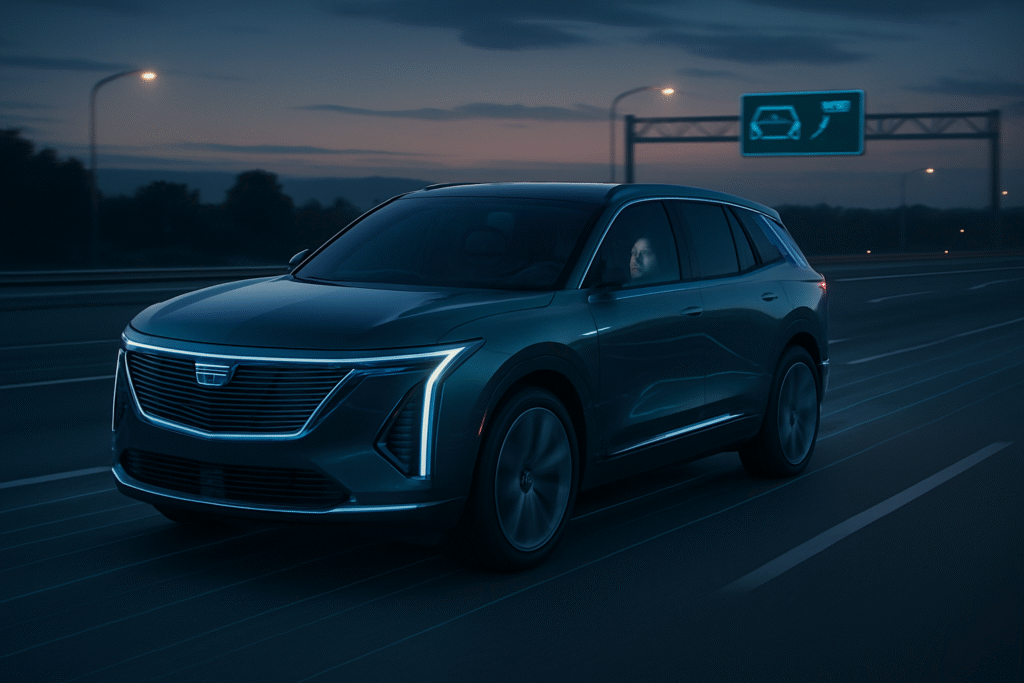
General Motors (NYSE: GM) is on the cusp of a significant advancement in personal mobility with its enhanced "eyes-off" Super Cruise technology, slated for debut in the 2028 Cadillac Escalade IQ electric SUV. This evolution marks a pivotal strategic move for GM, shifting its autonomous driving focus towards consumer vehicles and promising a new era of convenience and productivity on the road. While the rollout of this Level 3 conditional automation system is described as strategic to build trust, the underlying ambition is clear: to redefine the driving experience by allowing drivers to truly disengage on compatible highways.
This development comes at a crucial time for the autonomous vehicle industry, as companies grapple with the complexities of deploying self-driving technology safely and reliably. GM's approach, leveraging extensive real-world data from its existing Super Cruise system and integrating advanced AI from its now-shuttered Cruise robotaxi unit, positions it as a formidable contender in the race for higher levels of autonomy in personal vehicles.
Unpacking the Technology: From Hands-Free to Eyes-Off
The enhanced Super Cruise represents a substantial leap from GM's current "hands-free, eyes-on" system. The fundamental distinction lies in the level of driver engagement required:
- Hands-Free (Current Super Cruise): This Level 2 system allows drivers to remove their hands from the steering wheel on over 750,000 miles of compatible roads across the U.S. and Canada. However, drivers are still legally and practically required to keep their eyes on the road, with an in-cabin camera monitoring their gaze to ensure attentiveness.
- Eyes-Off (Enhanced Super Cruise): Set for 2028, this SAE Level 3 autonomous feature will permit drivers to divert their attention from the road entirely—to read, text, or watch content—while the vehicle handles driving on eligible highways. The system will clearly signal its active status with distinctive turquoise lighting on the dashboard and exterior mirrors. The driver is still expected to be ready to intervene if the system requests it.
This significant upgrade is powered by a new, centralized computing platform, also arriving in 2028. This platform promises a monumental increase in capabilities, boasting up to 35 times more AI performance, 1,000 times more bandwidth, and 10 times greater capacity for over-the-air (OTA) updates compared to previous GM systems. This robust architecture will consolidate dozens of electronic control units into a single core, enabling real-time safety updates and continuous learning. Some reports indicate this platform will utilize NVIDIA (NASDAQ: NVDA) Thor chipsets, signifying a move away from Qualcomm (NASDAQ: QCOM) Snapdragon Ride chips for this advanced system.
The underlying sensor architecture is a critical differentiator. Unlike some competitors that rely solely on vision, GM's "eyes-off" Super Cruise employs a redundant multi-modal sensor suite:
- LiDAR: Integrated into the vehicle, LiDAR sensors provide precise 3D mapping of the surroundings, crucial for enhanced precision in complex scenarios.
- Radar: Provides information on the distance and speed of other vehicles and objects.
- Cameras: A network of cameras captures visual data, identifying lane markings, traffic signs, and other road features.
- GPS: High-precision GPS data ensures the vehicle's exact location on pre-mapped roads.
This sensor fusion approach, combining data from all inputs, creates a comprehensive and robust understanding of the environment, a key safety measure.
Initial reactions from the AI research community and industry experts have been largely positive, viewing this as a major upgrade that positions GM as a strong contender in the advanced autonomous driving space. The focus on predictable highway conditions for the "eyes-off" system is seen as a pragmatic approach to maintaining GM's impressive safety record, which currently stands at over 700 million hands-free miles without a single reported crash attributed to the system. Experts also appreciate the removal of constant driver gaze monitoring, provided the system delivers robust performance and clear handover requests.
Industry Implications: Reshaping the Automotive Landscape
GM's move towards "eyes-off" Super Cruise carries profound implications for AI companies, tech giants, and startups, potentially reshaping competitive dynamics and market strategies.
General Motors (NYSE: GM) itself stands to benefit most, solidifying its position as a leader in consumer-ready Level 3 automation. This enhances its market appeal, attracts tech-savvy buyers, and opens new revenue streams through subscription services for its proprietary software. The strategic integration of AI models and simulation frameworks from its former Cruise robotaxi subsidiary provides GM with a proprietary and deeply experienced foundation for its autonomous technology, a significant advantage.
NVIDIA (NASDAQ: NVDA) is a major beneficiary, as GM transitions its advanced compute platform to NVIDIA chipsets, underscoring NVIDIA's growing dominance in providing hardware for sophisticated automotive AI. Conversely, Qualcomm (NASDAQ: QCOM) faces a competitive setback as GM shifts its business for this next-generation platform.
For Google (NASDAQ: GOOGL), the immediate future sees its Gemini AI integrated into GM vehicles starting in 2026 for conversational interactions. However, GM's long-term plan to develop its own custom AI suggests this partnership may be temporary. Furthermore, GM's controversial decision to phase out Apple (NASDAQ: AAPL) CarPlay and Google Android Auto across its vehicle lineup, opting for a proprietary infotainment system, signals an escalating battle over the in-car digital experience. This move directly challenges Apple and Google's influence within the automotive ecosystem.
Startups in the autonomous driving space face a mixed bag. While the validation of Level 3 autonomy could encourage investment in niche areas like advanced sensor development or V2X communication, startups directly competing with GM's comprehensive Level 3 ADAS or aiming for full Level 4/5 self-driving face increased pressure. GM's scale and in-house capabilities, bolstered by Cruise's technology, create a formidable competitive barrier. This also highlights the immense capital challenges in the robotaxi market, potentially causing other robotaxi startups to reconsider their direct-to-consumer strategies.
The broader trend of vertical integration in the automotive industry is reinforced by GM's strategy. By controlling the entire user experience, from autonomous driving software to infotainment, automakers aim to secure new revenue streams from software and services, fundamentally altering their business models. This puts pressure on external AI labs and tech companies to demonstrate unique value or risk being marginalized.
Wider Significance: Trust, Ethics, and the AI Evolution
GM's "eyes-off" Super Cruise fits squarely into the broader AI landscape as a tangible example of advanced AI moving from research labs to mainstream consumer applications. It reflects an industry trend towards incremental, trust-building deployment of autonomous features, learning from the challenges faced by more ambitious robotaxi ventures. The integration of conversational AI, initially via Google Gemini and later GM's own custom AI, also aligns with the widespread adoption of generative and multimodal AI in everyday technology.
However, this advancement brings significant societal and ethical considerations. The "handover problem" in Level 3 systems—where the driver must be ready to take control—introduces a critical challenge. Drivers, disengaged by the "eyes-off" capability, might become complacent, potentially leading to dangerous situations if they are not ready to intervene quickly. This raises complex questions of liability in the event of an accident, necessitating new legal and regulatory frameworks.
Safety remains paramount. While GM touts Super Cruise's perfect safety record, the transition to "eyes-off" driving introduces new variables. The system's ability to safely handle "edge cases" (unusual driving scenarios) and effectively prompt human intervention will be under intense scrutiny. Regulatory bodies like the National Highway Traffic Safety Administration (NHTSA) are already closely examining autonomous driving technologies, and the patchwork of state and federal regulations will continue to evolve. Furthermore, the broader advancement of autonomous vehicles, including systems like Super Cruise, raises long-term concerns about job displacement in industries reliant on human drivers.
Compared to previous AI milestones, "eyes-off" Super Cruise builds upon decades of automotive AI development. It stands alongside other advanced ADAS systems like Ford (NYSE: F) BlueCruise and Mercedes-Benz (ETR: MBG) Drive Pilot, with GM's multi-sensor approach offering a distinct advantage over vision-only systems. The integration of conversational AI parallels breakthroughs in large language models (LLMs) and multimodal AI, making the vehicle a more intelligent and interactive companion.
Public perception and trust are critical. While Level 3 promises convenience, it also creates a unique challenge: convincing drivers that the system is reliable enough to allow disengagement, yet ensuring they remain ready to intervene. Clear communication of limitations, thorough driver training, and consistent demonstration of robust safety features will be essential to build and maintain public confidence.
The Road Ahead: Future Developments and Challenges
Looking ahead, GM's "eyes-off" Super Cruise is poised for continuous evolution, with both near-term refinements and ambitious long-term goals.
In the near term (leading up to 2028), GM will continue to aggressively expand the compatible road network for Super Cruise, aiming for over 750,000 miles across North America by the end of 2025. This expansion will include minor highways and rural roads, significantly broadening its usability. Starting in 2026, the integration of Google Gemini for conversational AI will be a key development, enhancing natural language interaction within the vehicle.
The long-term vision, centered around the 2028 launch of the "eyes-off" system in the Cadillac Escalade IQ, involves the new centralized computing platform as its backbone. While initially confined to highways, the ultimate goal is to extend "eyes-off" driving to more complex urban environments, offering a truly comprehensive autonomous experience. This will require even more sophisticated sensor fusion and AI processing to handle the unpredictable variables of city driving.
Key challenges remain. Ensuring drivers understand their responsibilities and are prepared for intervention in a Level 3 system is paramount. The technical sophistication required to safely extend "eyes-off" driving beyond highways to urban environments, with their myriad of pedestrians, cyclists, and complex intersections, is immense. Maintaining the accuracy of high-definition LiDAR maps as road conditions change is an ongoing, substantial undertaking. Furthermore, navigating the evolving global regulatory and legal frameworks for higher levels of autonomy will be crucial.
Experts predict that GM's Super Cruise, particularly its transition to Level 3, will solidify its position as a leader in ADAS. GM anticipates that Super Cruise could generate approximately $2 billion in annual revenue within five years, primarily through subscription services, underscores the growing financial importance of software-driven features. Most experts foresee a gradual, incremental adoption of higher levels of autonomy rather than a sudden leap, with only a small percentage of new cars featuring Level 3+ autonomy by 2030. The future of the automotive industry is increasingly software and AI-defined, and GM's investments reflect this trend, enabling continuous improvements and personalized experiences through OTA updates.
Comprehensive Wrap-Up: A New Era of Driving
GM's "eyes-off" Super Cruise represents a monumental step in the journey towards autonomous driving. By leveraging a robust multi-sensor approach, a powerful new computing platform, and the invaluable data and AI models from its Cruise robotaxi venture, GM is making a strategic play to lead in consumer-ready Level 3 automation. This development is not just about a new feature; it's about fundamentally rethinking the driving experience, promising enhanced comfort and productivity for drivers on compatible roads.
In the history of AI, this marks a significant moment where advanced artificial intelligence is being integrated into mass-market personal vehicles at a higher level of autonomy. It showcases an adaptive approach to AI development, repurposing research and data from one challenging venture (robotaxis) to accelerate another (consumer ADAS). The long-term impact could transform how we perceive and utilize our vehicles, making long journeys less fatiguing and turning cars into intelligent, evolving companions through continuous software updates and personalized AI interactions.
In the coming weeks and months, watch for the initial rollout of Google Gemini AI in GM vehicles starting in 2026, providing the first glimpse of GM's enhanced in-car AI strategy. Monitor the continued expansion of the existing hands-free Super Cruise network, which is projected to reach 750,000 miles by the end of 2025. Crucially, pay close attention to further announcements regarding the specific operational domains and features of the "eyes-off" system as its 2028 debut approaches. The performance and safety data of current Super Cruise users will continue to be vital in building public confidence for this more advanced iteration, as the industry collectively navigates the complex path to a truly autonomous future.
This content is intended for informational purposes only and represents analysis of current AI developments.
TokenRing AI delivers enterprise-grade solutions for multi-agent AI workflow orchestration, AI-powered development tools, and seamless remote collaboration platforms.
For more information, visit https://www.tokenring.ai/.





